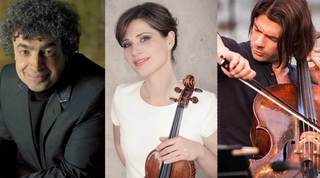|
Back
And the Brahms Bursting O'erhead... New York
David Geffen Hall, Lincoln Center
10/21/2015 - & October 22, 23, 24, 2015
Detlev Glanert: Brahms-Fantasie, Heliogravure for Orchestra (New York Premiere)
Johannes Brahms: Concerto in A minor for Violin, Cello and Orchestra, Opus 102 – Symphony No. 1 in C Minor, Opus 68
Lisa Batiashvili (Violin), Gautier Capuçon (Cello)
New York Philharmonic Orchestra, Semyon Bychkov (Conductor)

L. Batiashvili, S. Bychkov, G. Capuçon (© New York Philharmonic)
Lisa Batiashvili, Gautier Capuçon, and Semyon Bychkov did their very best in this–almost–all Brahms concert. But for reasons having nothing to do with the Phil concerts this week, it was difficult to hear. The reason was that Canadian film director Guy Maddin–who I consider the most eccentric and fascinating director in the whole wide world–has his latest movie here, The Forbidden Room. The music (which can barely be heard but is always present) includes part of the Schoenberg Chamber Symphony, a little Mosolov, a lot of Mussorgsky and Wagner.
And for the End of the World (which comes in the middle of the movie), he uses part of the Brahms Second Symphony. A movement which fits perfectly, which is totally absurd, and which I can’t get out of my mind.
So even when Semyon Bychkov, a favorite in New York, was conducting a tough First Symphony, ending off with an absolutely incendiary finale, it was difficult to keep his deft conducting skills in mind. The Philharmonic responds with alacrity to his motions. The first three movements, though, could have been conducted by any of the Phil’s guests. It was only after the great Philip Meyers’ last-movement horn solo that the orchestra rose up to a roaring conclusion.
That work is played all too often. The Double Concerto is rarely performed. It needs two players who are not only brilliant soloist in their own right–but soloists who can contain their own egos for 34 minutes to make a team.
The team last night had one fiercely aggressive player. Cellist Gautier Capuçon, like the first mover in a game of chess, took the lead, and never held back. My own score says his first measures are “recitative style”, but Mr. simply sailed off with these themes. Whatever Mr. Bychkov wanted, the soloist went his own way.
Which meant that violinist Lisa Batiashvili had no choice but to give near exaggeration to her introductory measures. And after that the two chased after each other with fraternal passion. Happily, the two are not similar in musical temperament. Mr. Capuçon is a splendidly energetic player, with a light touch when necessary, but always ready to take off. Ms. Batiashvili’s violin-playing has always been florid, sometimes sweet to a fault, technically perfect, but frequently giving the waft of perfume with her pyrotechnics.
And it was that difference which made this Concerto move forward. I’m uncertain of the term in physics, but the two pushed themselves along until the finale.
And this is where it came together. The Double Concerto was, I believe, Brahms’ last orchestral work. But the Vivace non troppo is a movement of utter youthfulness, even abandon. With the very young Gautier Capuçon whirling around the luminous notes of Ms. Batiashvili, and Mr. Bychkov offering the most broadly paced, never too fast finale, the music flew off the stage.
One important note which I don’t think the program mentioned. Ms. Batiashvili’s 1715 Stradivarius belonged at one time to Joseph Joachim. The Double Concerto was not only dedicated to Joachim, but that great Hungarian soloist helped Brahms with the technical parts. So–possibly–the sounds given by the great Georgian violinist were close to those of its original player.
The most original part of the program was the opening Brahms-Fantasie by the visiting German composer Detlev Glanert. He has never been performed in New York but I listened with rapture on YouTube to his amazing orchestration of Brahms’ Four Serious Songs with his own preludes. In fact, he has “transformed” many composers, including Mahler and Schubert. And his two main teachers, Hans Werner Henze and Oliver Knussen, both had been idiosyncratic enough, open enough and with enough styles of their own, to have helped him.
Like Brahms’ own “transformation” of Beethoven in the last movement of the First, Mr. Glanert changed Brahms, hinting that it was done through that very first photographic process called ‘heliogravure’. The method is too complicated for these pages. But basically, Mr. Glanert was attempting–very successfully–to emulate what Béla Bartók had said about his transposition of Magyar music: that it must “sound” Hungarian, without necessarily using Hungarian rhythms or harmonies.
The Brahms-Fantasie started with the first chords of the First Symphony–but divided into two chords. Which then divided into a 12-tone scale, which then continued with a whirligig of a piece that may have quoted Brahms (I caught the scintilla of a Hungarian dance), but more often was original Glanert. Mind you, he had some Brahms trademarks: the instruments in major thirds, the trombones coming in on the finale, and that kinetic sense of Brahms plunging into a set of variations which sounded nothing like the original theme.
It was a delicious piece. A whole concert of Brahms (along with the memorable quote from that great film Forbidden Room was quite an earful for an evening. But Mr. Glanert gave it an eccentric originality.
Harry Rolnick
|